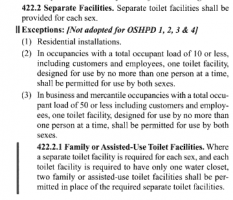JMichl
REGISTERED
Hello,
I'm clear that Los Angeles requires single occupancy restrooms to be relabeled as gender neutral.
What I can't seem to find anywhere is when are single occupancy Gender Neutral restrooms required to be built?
Specifically, if an office building is gutting an entire floor with a construction cost well over any threshold for compliance, is there any code or ordinance in Los Angeles that compels the addition of a new single occupant Gender Neutral restroom? (please specify any such ordinance or code so I can refer the our client to it)
Thank you in advance!
I'm clear that Los Angeles requires single occupancy restrooms to be relabeled as gender neutral.
What I can't seem to find anywhere is when are single occupancy Gender Neutral restrooms required to be built?
Specifically, if an office building is gutting an entire floor with a construction cost well over any threshold for compliance, is there any code or ordinance in Los Angeles that compels the addition of a new single occupant Gender Neutral restroom? (please specify any such ordinance or code so I can refer the our client to it)
Thank you in advance!



